Comprehensive workflow for the analysis of extractables and leachables from laboratory tubing
Using a quadrupole time-of-flight mass spectrometer with SWATH acquisition and SCIEX open access extractables and leachables high-resolution MS/MS spectral library
Rolf Kern1, Patty Sun1, Alex Liu1, Benben Song2 and Adrian M. Taylor3
1SCIEX, USA; 2Pall Corporation, USA; 3SCIEX, Canada
Abstract
An LC-MS/MS method for identification of extractables and leachables is demonstrated that can be implemented using the SCIEX X500R QTOF system. The method incorporates a photodiode array detector to allow non-ionizable compounds to also be detected. A SCIEX open access E&L high resolution MS/MS Spectral library is used for compound identification.
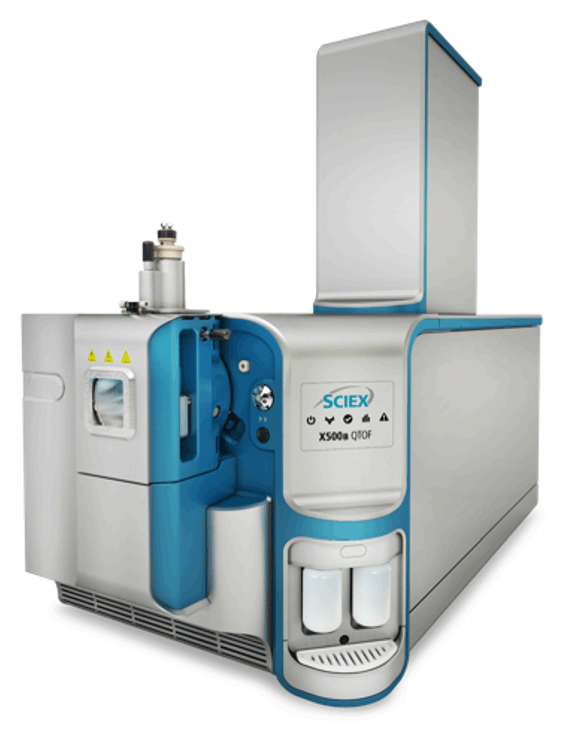
Introduction
The analysis requirements of extractable and leachable (E&L) compounds from products that come in contact with pharmaceutical products are described in the United States Pharmacopeia, chapters 1663 and 1664. The initial determination of non-volatile, organic E&L compounds is often done by high-resolution liquid chromatography-mass spectrometry using a time-of-flight (TOF) mass spectrometer run in Information Dependent Acquisition (IDA) mode. If compounds are present at low levels or chromatographically coelute with other compounds of interest, they may be missed using IDA. Here, an LC-MS/MS method using SWATH acquisition is coupled with spectrum matching against an E&L compound library to provide greater confidence that compounds of interest will not be missed during analysis.
Typical IDA methods generate MS/MS spectra only for the most intense precursor masses that exceed thresholds set in the method. As a result, the fragmentation data necessary to identify less intense precusor masses, in a busy TOF MS spectrum, are often not collected. SWATH acquisition is a data-independent scan type that works by stepping through a series of Q1 m/z windows, fragmenting all of the ions transmitted through Q1, without a bias for intensity.1 This approach ensures that important compounds are not omitted during analysis and improves the ablity to identify compounds of interest by use of the generated fragmentation data.
Figure 1. Compound identification workflow. Two strategies are used in this method for data processing to ensure the majority of compounds are detected and identified.
Key features of the X500R QTOF System for E&L analysis
- Sensitive, fast scanning, benchtop hybrid quadrupole time of flight mass spectrometer
- SWATH Acquisition enabled for the most comprehensive data independent analysis
- Retention time alignment deconvolution when processing the data provides clean spectra that can be used for structure elucidation or library searching.
- Intuitive SCIEX OS software for acquisition and data processing for quantitative and qualitative workflows
- SCIEX open access E&L high-resolution MS/MS spectral library composed using data acquired on a SCIEX accurate mass QTOF system. This library, in combination with powerful search algorithms, enables specific, sensitive, robust, accurate and efficient compound identification by matching data to library spectra acquired with similar experimental conditions.
Methods
Sample description: A sample of laboratory tubing soaked in acetone was generously provided by our collaborator.
Chromatography: Separation was performed on an ExionLC AD system with a photodiode array detector (PDA 200-400nm) using a Phenomenex Luna Omega c18 column (1.6µm, 150x2.1mm). See Table 1 for more details.
Table 1. Chromatographic conditions. Flow rate of 0.4 mL/min.
Mass spectrometry: Data acquisition was performed using the X500R QTOF system operating in SWATH acquisition mode. A TOF MS survey scan from 100–1300 m/z with an accumulation time of 50 ms was used, followed by 10 evenly divided 50 ms SWATH acquisition windows, covering 100–300 m/z. See Table 2 for the SWATH acquisition windows used. The mass range of each MS/MS spectrum was 50–1300 m/z with collision energy of 35 V and collision energy spread of 15 V. The resulting cycle time was ~0.6 seconds. Generic ESI source conditions were used in both polarities (GS1=40, GS2=40, CUR=25, ISV = +5500 / -5500).
Table 2. SWATH acquisition windows.
Data processing: All data were processed using the sample vs control qualitative workflow of the Analytics module in SCIEX OS software. Using this workflow, which is outlined in Figure 1, sample and control injections were compared after running the peak-finding algorithm. Only peaks in the sample that had areas greater than those found in the control by a threshold factor set in the method were selected for further evaluation.
Two levels of processing were used in the method to identify peaks of interest.
First, a targeted extraction list, which contained approximately 300 m/z values for known compounds, was included in the method. An extracted ion chromatogram (XIC) list is straightforward to generate and modify. It includes compound names, molecular formulas and, when known, retention times. Based on this information, the extraction mass is calculated by the software and the presence of chromatographic peaks is evaluated. The XIC list used for this study was based on a proprietary collection of historically identified compounds from a collaborator.
Second, a non-targeted peak-finding algorithm was used to identify and integrate signals from the TOF MS. Once peaks were identified by either method, the corresponding MS/MS spectra were searched against a library for identification.
If an acquired spectrum was not matched to a library spectrum, further evaluation of the peak would be performed using the direct integration of SCIEX OS software with ChemSpider. A molecular formula would be proposed based on the exact mass of the precursor and this formula would be searched in ChemSpider. The output of the ChemSpider search would include potential hits and MOL files. In silico fragmentation of the potential structures would be compared to the acquired MS/MS spectrum and the best match would selected by the user as the proposed compound.
E&L high-resolution MS/MS spectral library
The SCIEX open access E&L high-resolution MS/MS spectral library was used in this study. This library is a SCIEX instrument specific extractable and leachable compound MS/MS spectral library containing 675 E&L relevant compound entries. The library is open access and freely available to download from the SCIEX website in the standard SCIEX LibraryView software format (.lbp), allowing for easy access to a relevant E&L compound library source. The library includes polymer degrandants covering: nylon oligomers/degradants, polypropylene glycol (PPG) species, poly ethylene glycol (PEG) species, piperidinones, poly ethylene terephthalate (PET) species, poly (tetramethylene glycol) (PTMG) species and hydroxy-terminated polyethylene polyols. The library also contains other polymer components, preservatives, stabilizers, antioxidants, light stabilizers/UV absorbers and fatty acids.2 Together, a specific library match, retention time and mass error provide confidence in compound identifications. New compounds and spectra can easily be added to the library by users, which allows the library coverage to improve over time.
The SCIEX library can be combined with a curated subset of the licensed National Institute of Technology (NIST) MS/MS spectral library. The combination of the SCIEX and NIST libraries generates a comprehensive MS/MS spectral library containing relevant compounds. The current version of the curated NIST library contains approximately 3,000 spectra, acquired under varying experimental conditions and using different types of instruments. This combination of libraries can therefore reduce the frequency with which unknown E&L peaks go unidentified, while simultaneously increasing the likelihood of false positives.
Identification of polymer fragments and degradants using library matching
The supplied acetone-soaked tubing sample was processed using the non-target screening processing method in combination with a collaborator-supplied XIC list, using the SCIEX open access E&L high-resolution MS/MS spectral library and the curated NIST library. Many polymer degradant peaks listed in the supplied XIC list were observed in the sample and matched against compounds from the libraries. Other peaks were left unidentified and flagged for further investigation using the ChemSpider functionality. Examples of these samples will be introduced in detail.
High-resolution SWATH acquisition data acquired using the SCIEX QTOF systems provides investigators a powerful tool for the detection and identification of E&L compounds. As shown in the example in Figure 2, multiple criteria, including library matching, are used to improve confidence in the identification of E&L compounds from an acetone-soaked tubing sample. Automated processing matches the MS data to the analyte mass and the MS/MS data to the analyte fragmentation pattern in the library. These data provide a “purity score” for assessment of confidence in compound identification. This provides an overall hit score based on both ‘fit’ and ‘reverse fit’ properties.
Figure 2. Processed SWATH acquisition data using multiple identification criteria, including MS/MS library matching. The visual display is filtered to show the highest confidence identifications of E&L compounds from a laboratory tubing sample, based on mass error, retention time, isotope ratio and MS/MS library matching.
Figure 3 shows an example where multiple aspects of the high-quality data were used to detect and identify an E&L compound from an acetone-soaked tubing sample. In this example, a nylon degradant was identified with an excellent purity score for the spectral matching of the acquired MS/MS spectrum to the SCIEX open access E&L high-resolution MS/MS library spectrum.
Figure 3. Confident identification through the SCIEX open access E&L high-resolution MS/MS spectral library matching. A sample of acetone that was used to soak laboratory tubing was analyzed using SWATH acquisition on the SCIEX X500R QTOF system and the acquired data searched against the SCIEX open access E&L spectral library. The peak review option in the Analytics module of SCIEX OS software displays all data collected for a single peak. These data are analyzed to determine retention time from the chromatographic performance (left), the theoretical isotope pattern from the experimental TOF MS spectra (middle) and the SCIEX open access E&L library match from the MS/MS spectrum (right). The experimental SWATH acquisition MS/MS spectrum is displayed in blue, while the matching spectrum from the SCIEX open access E&L library is shown in the grey mirror plot. In this example, the nylon degradant identified provided a 98% purity score against the library MS/MS spectrum using the smart confirmation algorithm and using the Formula Finder feature with mass error (ME) of 0.8 ppm.
Improved specificity for increased confidence in identifications
The SCIEX open access E&L high-resolution MS/MS spectral library is composed of MS/MS spectra that have been acquired on a SCIEX QTOF system, allowing users to search against spectra that were acquired under similar conditions and using the same instrument. Figure 4 highlights how the use of a stringent search algorithm can reduce the number of library hits for review. This is accomplished by limiting search results by data acquisition method and therefore eliminating false positive matches to spectra from the curated NIST library that were acquired using different experimental conditions.
Figure 4. Comparison between relaxed and stringent library search parmaters. The results table on the left, outlined in blue, has been filtered to show the strong identifications (24 compounds) made from the laboratory tubing sample when using relaxed search algorithm parameters to search both the NIST MS/MS spectral library and the SCIEX open access E&L MS/MS spectral library. The table on the right, outlined in green, shows that fewer strong identifications (15 compounds) are made from the same dataset and libraries, using stringent search parameters that limit results based on acquisition method.
A less stringent search algorithm is required to search the NIST library and generate more library hits to review, as shown in Figure 4. Searches involving the NIST library may be necessary in some cases to identify peaks, however, many of these additional library matches are false positives. Figure 5 shows an example in which the experimental MS/MS spectrum visibily does not match the library spectrum for stearamide from the NIST library. This library hit was specific to the NIST library. Therefore, had more stringent search algorithms been implemented, this erroneous result would have been avoided. The specific, sensitive and robust library matching, in combination with retention time and mass error, provide confidence in the accuracy of identifications and reduce the time spent by the user reviewing results.
Figure 5. Example of a false positive hit for stearamide using the relaxed search parameters. When using the relaxed search parameters, marginal hits are reported that require review, indicated by the yellow triangle in the top row of the table. Based on these inclusion criteria, potential hits often include cases in which the experimental MS/MS spectrum visibily does not match the library spectrum, as shown in the panel on the right. Using the more stringent SCIEX-specific search parameters, false positive matches are filtered out before the review process, indicated by the red circles in the bottom row of the table, resulting in higher quality matches.
Combination of the SCIEX E&L library and the curated NIST library
Using the combination of the curated E&L NIST database and the new SCIEX open access library can provide identifications for compounds that are not currently contained in the open access library. This combination was used to identify oleamide (Figure 6), by matching the MS/MS spectral data acquired for the XIC peak at 12.8 minutes, to the NIST oleamide library MS/MS library spectrum. In this example, failure to implement the NIST database would have left this XIC peak unidentified and therefore would have required more extensive analysis. The SCIEX curated library provides the highest confidence hits, but combining with the NIST library allows for missing compounds to be identified.
Figure 6. Enhanced coverage by combining the SCIEX E&L library and curated NIST library. By combining the high quality SCIEX E&L library with the more extensive NIST E&L subset library, the accuracy of the compound search is improved by reducing the occurrence of false negatives and the frequency with which unknown E&L peaks are not identified.
Figure 7. Unidentified compound from library search. An example component flagged as interesting in the sample and that lacked a library match.
Formula Finder in SCIEX OS Software automatically calculates a formula of C17H35N2O2 with an error of less than 1ppm. When this formula is searched against ChemSpider, over 500 possible compounds are returned. The SCIEX OS software interfaces with ChemSpider to compare chemical structures with the experimental MS/MS spectra to identify likely matches. This process results in a curated list of structures that correspond well to the observed fragmentation pattern (Figure 8).
Confirmation of this compound would necessitate procuring an authentic standard for analysis and direct comparison with the sample results. The MS/MS spectra generated by this experiment could then be added to the library for easier identification in the future. In cases in which an authentic standard cannot be obtained, it may be sufficient to request information from the tubing sample vendor to determine whether the observed MS/MS spectra could have been generated, given their manufacturing, storage and packaging processes.
Figure 8. ChemSpider results for m/z 314.28. Proposed structure, MS/MS and table listing in-silico fragments and their alignment to observed MS/MS fragments. Observed fragments not assigned to simulated fragments are shown in orange.
Unidentified polymer fragments and degradants
One of the necessary and complex aspects to analyzing extractable compounds from pharmaceutical storage products is achieving confident identification of polymer fragments and degradants. Some classes of polymers require analysis by GC based techniques. For others, like nylon-based polymers that incorporate nitrogen into their structure, LC-MS/MS can be used, as shown in Figure 9. This is further complicated because authentic standards are not commercially available for many compounds of interest and variations of the polymer backbone can be observed. Currently, suspected degradants can be tentatively identified using chemical formulas that correspond to known or suspected combinations of the polymer monomers.3 Further work is required to develop a more comprehensive approach to identify and characterize extractable compounds.
Figure 9. Nylon degradant found by sample vs control comparison. XIC for a nylon degradant found in the sample, but absent in the control (left). The chemical formula is shown in the right panel, where the experimental TOF MS plot is shown in blue and the calculated MS spectrum is shown in the grey mirror plot.
Optical detection
Optical detection techniques (UV, PDA) are often incorporated into LC-MS based workflows to ensure that compounds that are not ionized during electrospray ionization are not missed. In this study, there were no significant peaks observed in the PDA trace that were not identified in the MS survey of the sample. This was expected, as modern LC-MS/MS is more sensitive than most optical techniques. Figure 10 shows the PDA and MS signals for a bis-2-ethylhexyl phthalate standard, which exhibited a good response using both techniques. Untargeted peak finding using the optical signal can be done in SCIEX OS software.
Figure 10. Example of optical detection. (Top) TOF MS XIC and MS/MS XIC from SWATH acquisition experiment for bis-2-ethylhexyl phthalate standard. (Bottom) Total wavelength chromatogram, showing >2 second RT offset.
Conclusions
Here, example data for a high-resolution LC-MS/MS E&L workflow using SWATH acquisition has been demonstrated using the X500R QTOF system. The method incorporates a photodiode array detector to allow non-ionizable compounds to be detected. The SCIEX open access E&L high-resolution MS/MS spectral library was used to search high-resolution MS/MS spectra for high-confidence compound identification. This library, in combination with powerful search algorithms, enables specific, sensitive, robust, accurate and efficient compound identification through instrument-specific library MS/MS spectral matching. The library can be combined with a curated subset of the licensed NIST MS/MS spectral library to provide a more comprehensive MS/MS spectral library bundle that contains relevant E&L compounds for enhanced coverage. Users can easily add compound spectra to their library, which allows compound coverage for their assay to grow in a focused manner.
References
- Improved data quality using variable Q1 window widths in SWATH acquisition - data independent acquisition on TripleTOF and X-Series QTOF systems. SCIEX technical note, RUO-MKT-02-2879-B.
- Confident identification in extractable and leachable screening. SCIEX technical note, RUO-MKT-02-14108-A
- Characterization of a complex ethoxylated propoxylated alcohol polymer mixture using LC-HRMS and Kendrick mass defect (KMD) analysis. SCIEX technical note, RUO-MKT-02-12838-A.
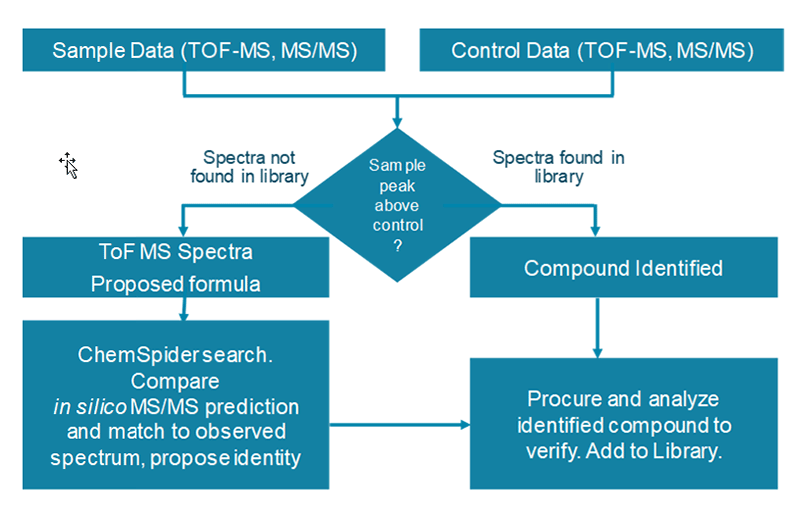 Click to enlarge
Click to enlarge Click to enlarge
Click to enlarge Click to enlarge
Click to enlarge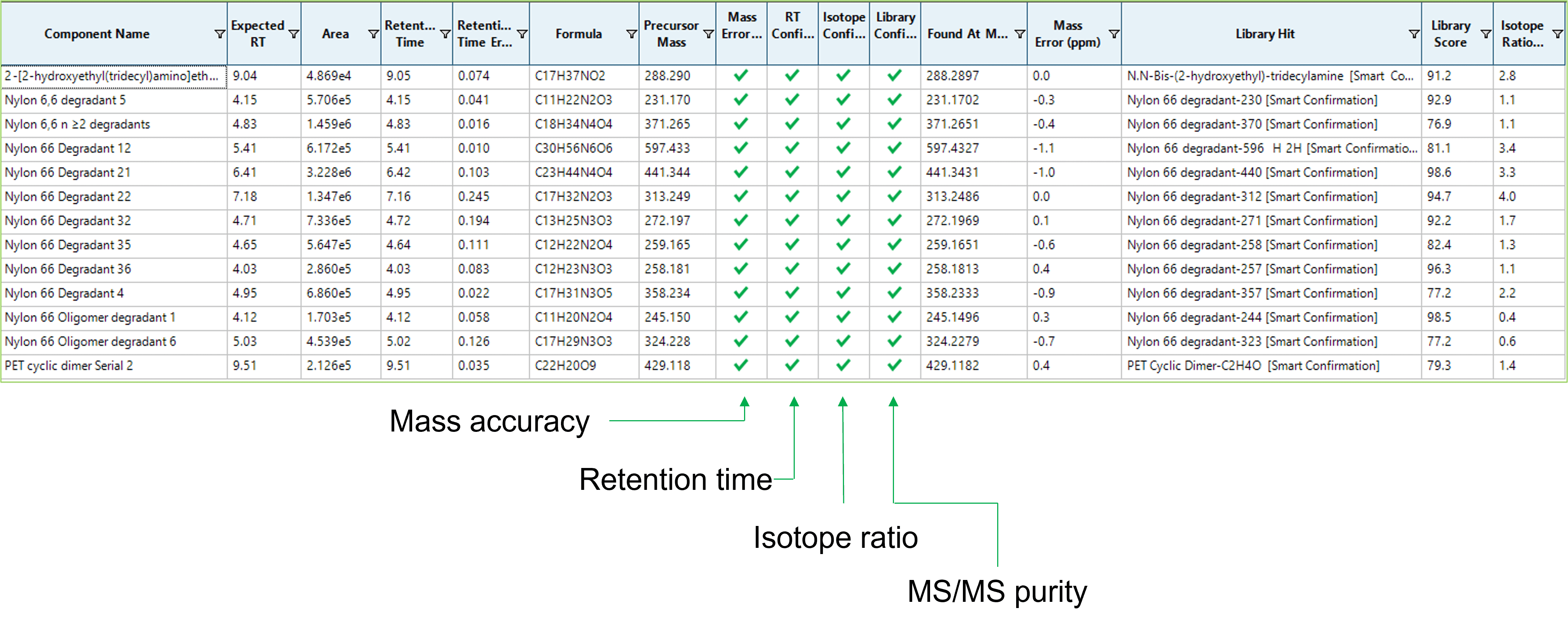 Click to enlarge
Click to enlarge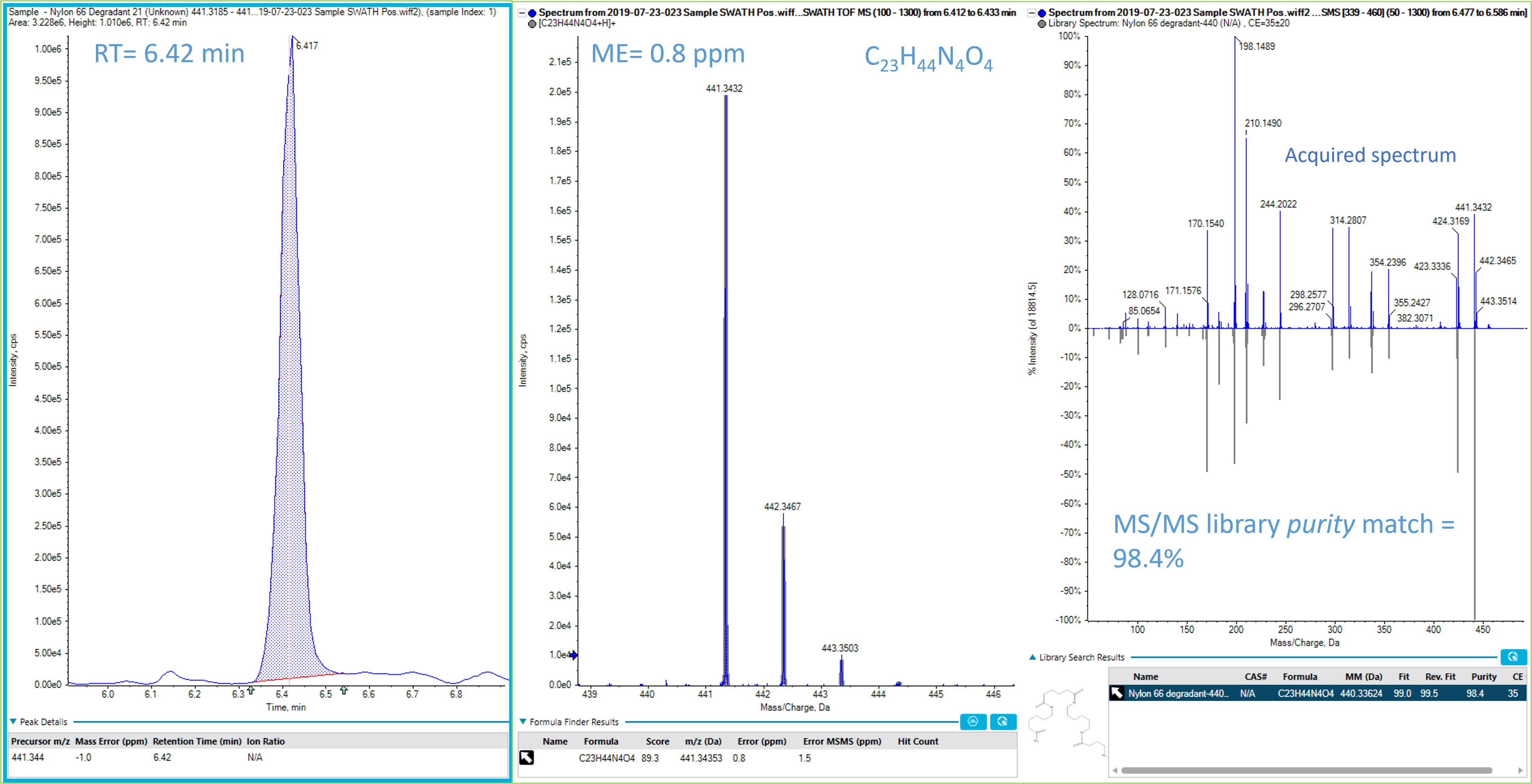 Click to enlarge
Click to enlarge Click to enlarge
Click to enlarge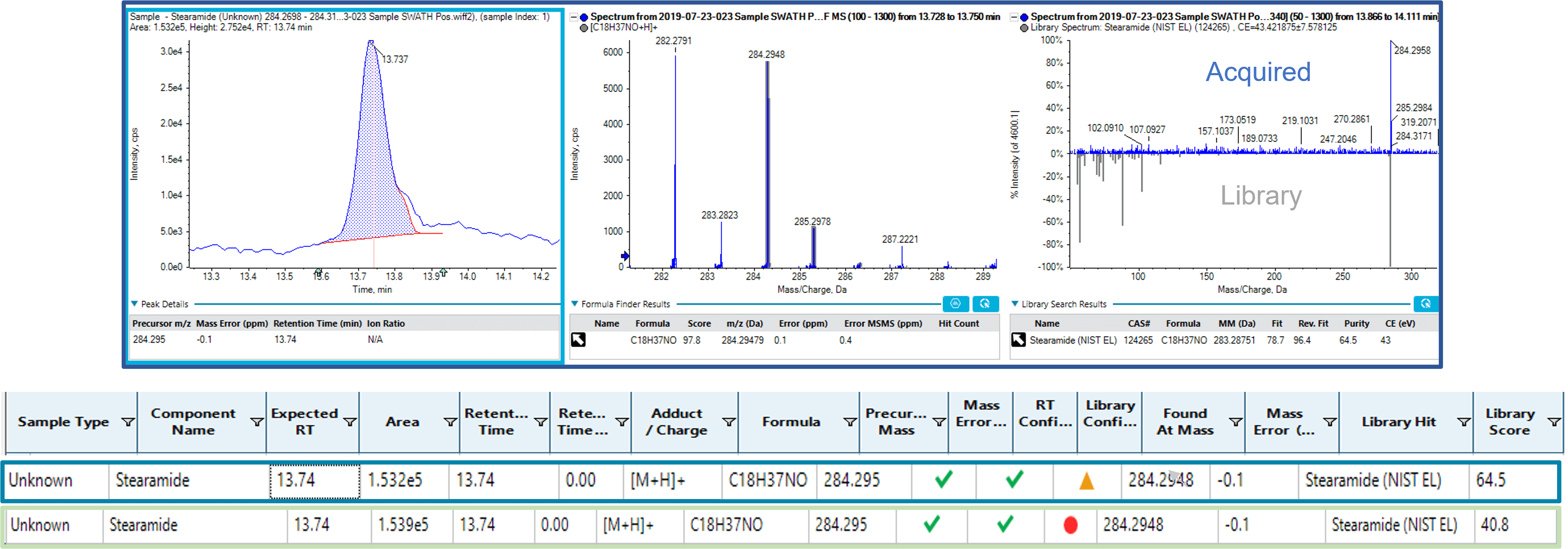 Click to enlarge
Click to enlarge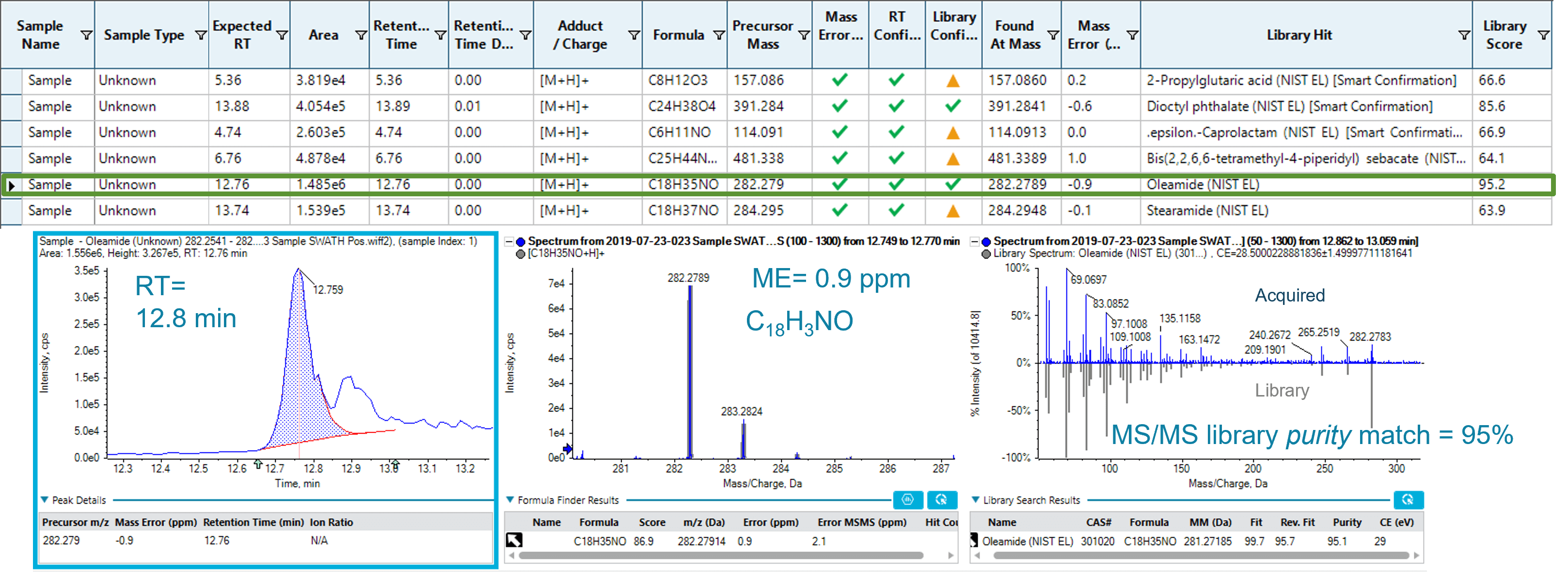 Click to enlarge
Click to enlarge Click to enlarge
Click to enlarge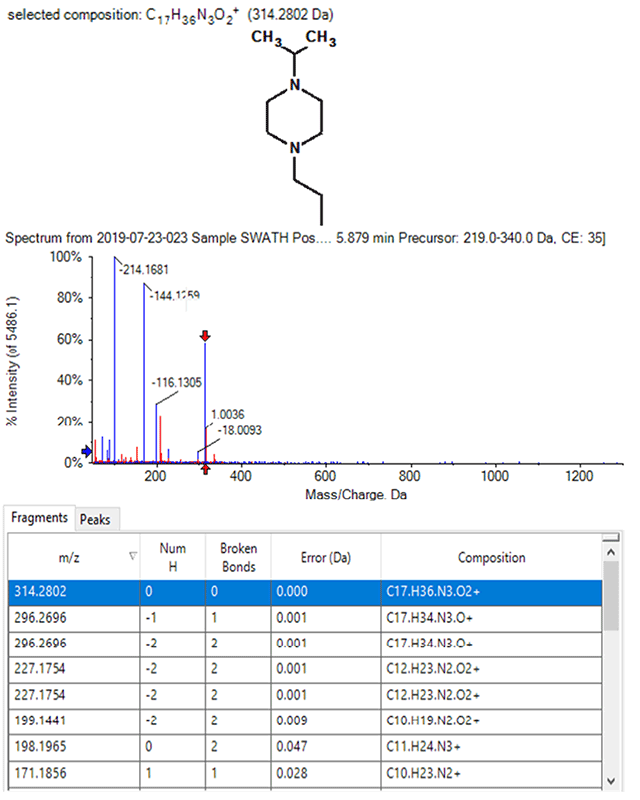 Click to enlarge
Click to enlarge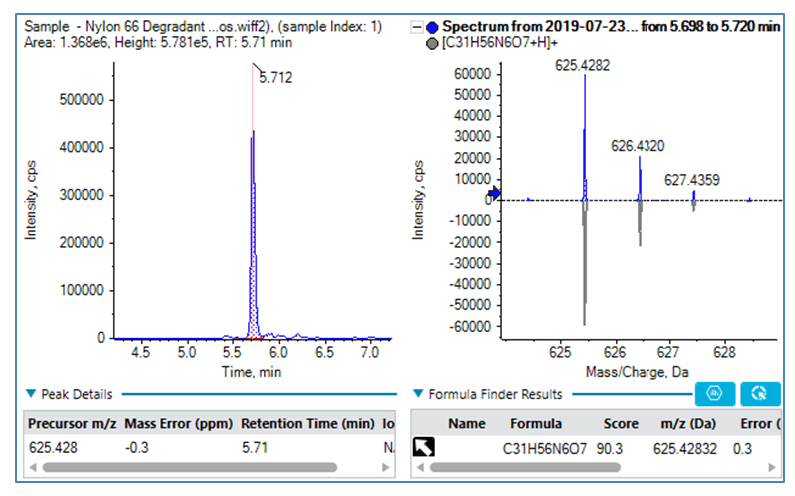 Click to enlarge
Click to enlarge Click to enlarge
Click to enlarge